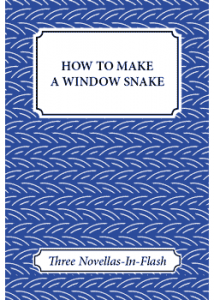Charmaine Wilkerson will give a copy of How to Make a Window Snake to the writer of the story she selects for publication!
You have a novella in the book How to Make a Window Snake (which also includes novella by two other writers, UK-based Ingrid Jendrzejewski and Joanna Campbell. The stories were chosen by judge Meg Pokrass in the Bath Novella-in-Flash competition in 2017. Can you tell us about your process of writing novellas in flash? Did you set out with this form in mind or did it present itself during the writing process? Any advice for other writers interested in writing novellas in flash?
 Unlike the other two authors, I didn’t set out to construct a novella-in-flash. When I write fiction, I tend to be a pantser, the kind of writer who starts scribbling without a strictly-defined structure. Then I take it from there. I was developing a story about this family and it kept bubbling to the surface in short bursts that felt like pieces of flash fiction. Later, I asked myself hard questions about structure. Could each chapter really hold up as a separate piece of flash fiction? Was the overarching story truly coherent, even as I crossed timelines and introduced various points of view? My advice to other pantsers is to enjoy letting your mind wander, at first, have respect for your subconscious mind and leave it room to develop the story. Then stop, periodically, to take a look at structure. I like to take a pencil and paper and diagram the characters or key points in the timeline, or just jot down the connections that I’m finding in my story. For example, I found that the window snake, which was thrown into the story as an afterthought, later emerged as a major symbol of what the characters needed to do to thrive.
Unlike the other two authors, I didn’t set out to construct a novella-in-flash. When I write fiction, I tend to be a pantser, the kind of writer who starts scribbling without a strictly-defined structure. Then I take it from there. I was developing a story about this family and it kept bubbling to the surface in short bursts that felt like pieces of flash fiction. Later, I asked myself hard questions about structure. Could each chapter really hold up as a separate piece of flash fiction? Was the overarching story truly coherent, even as I crossed timelines and introduced various points of view? My advice to other pantsers is to enjoy letting your mind wander, at first, have respect for your subconscious mind and leave it room to develop the story. Then stop, periodically, to take a look at structure. I like to take a pencil and paper and diagram the characters or key points in the timeline, or just jot down the connections that I’m finding in my story. For example, I found that the window snake, which was thrown into the story as an afterthought, later emerged as a major symbol of what the characters needed to do to thrive.
You currently live in Italy. As a fellow expat, I have to ask how this impacts your writing. Do you find it influences the themes you’re interested in?
I was raised between two countries in a multicultural family, attended universities in two very different parts of the US and currently live in yet another area of the world. So, I see the influence of this multilocal experience in some of my writing. My characters may be in-betweeners dealing with shifting concepts of home, identity and morality. They may struggle against other people’s narratives of whom they should be and how they should live. Which doesn’t mean that these characters have to travel anywhere. These can be issues for people who have never left their hometowns.
What is a book you’ve read this year that you can’t stop thinking about?
I’m going to be naughty and name not one but two books that have stayed with me because they are similar in a couple of key ways. Nod Ghosh’s The Crazed Wind (Truth Serum Press) and Johanna Robinson’s Homing (Ad Hoc Fiction) are both novellas-in-flash put out by small presses which offer intriguing references to historical situations that get little or no coverage in short fiction. They also use memorable language to address some of the universal personal issues which we, as writers, tend to address repeatedly. Issues like loss, separation, love, intergenerational conflicts. These books show that these themes can be tackled in fresh ways.
And finally, what kind of story would you love to find in your queue this week?
I’ll be looking for language that pulls me right in. Something that I can see, hear, smell or feel or an initial idea that sets off a ping in my head and makes me sit up straighter as I read. But there has to be a story there, a sense of movement, a sense that something has shifted in the reality of the characters in the flash, not just a series of interesting sentences, as beautifully crafted as they may be.


 The core workshop of SmokeLong Fitness is all in writing, so you can take part from anywhere at anytime. We are excited about creating a supportive, consistent and structured environment for flash writers to work on their craft in a community. We are thrilled and proud to say that our workshop participants have won, placed, or been listed in every major flash competition. Community works.
The core workshop of SmokeLong Fitness is all in writing, so you can take part from anywhere at anytime. We are excited about creating a supportive, consistent and structured environment for flash writers to work on their craft in a community. We are thrilled and proud to say that our workshop participants have won, placed, or been listed in every major flash competition. Community works.